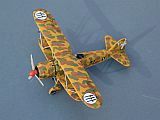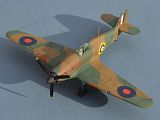April 2023
Hawker Hurricane Mk.1
Fiat CR.42 Falco
Fiat CR.42 Falco
97 Squadriglia, 9 Gruppo, 4 Stormo, Comiso Airfield, Sicily July 1940.
Italeri 1/72

© www.gengriz.co.uk
Background -
The Fiat CR.42 Falco ('Falcon', plural: Falchi) was designed by Celestino Rosatelli
(hence CR.42) as a single-
Falchi served in large numbers across the Mediterranean theatre. Although obsolete
by the start of the war, Italian pilots liked it because of its exceptional structural
strength and manoeuvrability. It was fast for a biplane, although not heavily armed
-
97 Sq, 9 Gruppo, 4 Stormo was the first Italian unit to receive the new MC.200 Saetta fighter in 1940. However, the pilots preferred their familiar CR.42 biplanes. and quickly swap with 1 Stormo, who were delighted to acquire the latest fighters . After a period of operations over the Alps until the French surrender, during July 1940 they flew escort to bombers over Malta, then 11th July, 9 Gruppo were redeployed to Libya and replaced by 23 Gruppo, another CR.42 unit also operating out of Comiso airfield in Sicily.
In a strange twist of irony, the high speed modern MC.200s that had been outmanoeuvred in June 1940 by the antiquated but agile Sea Gladiators of the Hal Far Fighter Flight, were replaced by the agile and antiquated CR.42, but immediately found themselves operating against the faster and modern Hurricanes, who suffered the same mismatched performance difficulties that their opponents had faced the previous month.
Building the Italeri CR.42 Falco Kit:
One of Italeri's greatest strengths, for obvious reasons, is its excellent range
of Italian WW2 aircraft. Sometimes they are the only kit available of a specific
type, but even when not, they are usually the best kit of a specific type. The Fiat
CR.42 Falco was one of the most successful of Italian WW2 fighters. Like the British
Gloster Gladiator, it was obsolete almost as soon as the war began, but its strength
and agility allowed it to continue in combat service for many years. Unusually, the
CR.42 was a "Sesquiplane", with lower wings much shorter than the upper ones. 
Italeri's kit was first issued in 2006 and has seen several re-
As with any Biplane, assembling the wings can pose a few challenges. The ribbed fabric effect on the wings is a little disappointing, with the ribs badly overdoen, although this is not too obvious when complete and a little sanding would help. The diagonal struts are a problem, as they provide little guidance as to the wing position. The modeller needs to follow the kit instruction diagram very precisely to ensure the right strut is in the right position and trust that the final fit an wing stagger will work out as intended! I assembled the struts to the upper wing then attached the fuselage cabane struts first, then bent everything until the wing struts fitted. In retrospect, I would have left the outer struts off until the cabane and first interplane ones were attached. This would have given a little more working room and some flexibility in attachment.
The kit engine merits particular mention; it is very nicely moulded in 8 delicate
parts. Determining which way the block fits on the after cowling/cooling flap section
is a little tricky -
For my kit I am building as an aircraft that flew over Malta, so the otherwise superb
kit decals have been used as a basis for change. As supplied, this recent "Battle
of Britain" issue of the Italeri kit provides 6 options, with colour placement diagrams
for 2 aircraft that flew from Belgium during the Battle Of Britain and a set of 4
Libyan-
Painting Italian schemes is always a challenge for the brush-
This is a pleasing kit, with some difficult steps, but one that is well worth the effort. It definitely makes an interesting comparison with the Sea Gladiator and contrast with the Hurricane!
Link to many more Axis aircraft kit builds on my “Other Side” pages
Part 1









